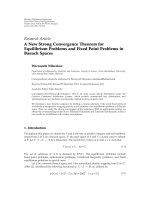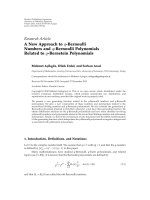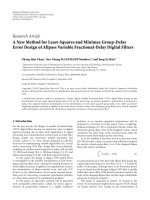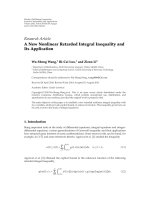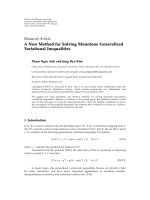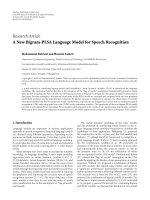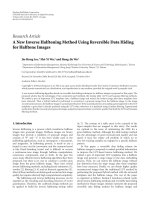Báo cáo hóa học: " Research Article A New Method for Identifying the Life Parameters via Radar" pot
Bạn đang xem bản rút gọn của tài liệu. Xem và tải ngay bản đầy đủ của tài liệu tại đây (1.33 MB, 8 trang )
Hindawi Publishing Corporation
EURASIP Journal on Advances in Signal Processing
Volume 2007, Article ID 31415, 8 pages
doi:10.1155/2007/31415
Research Article
A New Method for Identifying the Life Parameters via Radar
Wang Jianqi,
1, 2
Zheng Chongxun,
1
Lu Guohua,
2
and Jing Xijing
2
1
The Key Laboratory of Education, Ministry of China, Xi’an Jiaotong University, Xi’an 710049, China
2
Department of Biomedical Engineering, The Fourth Military Medical University, Xi’an 710032, China
Received 10 January 2006; Revised 22 September 2006; Accepted 6 October 2006
Recommended by Ulrich Heute
It has been proved that the vital signs can be detected via radar. To better identify the life parameters such as respiration and
heartbeat, a novel method combined with several signal processing techniques is presented. Firstly, to improve the signal-to-noise
ratio (SNR) of the life signals, the signal accumulation technique by FFT is used. Then, to restrain the interferences produced by
moving objects, a dual filtering algorithm (DFA) which is able to remove the interferences by tracing the interfering spectral peaks
is proposed. Finally, the wavelet transform is applied to separate the heartbeat from the respiration signal. The method cannot only
help to automatically detect the existence of human beings effectively, but also identifying the parameters like respiration, heart-
beat, and body-moving signals significantly. Experimental results demonstrated that the method is very promising in identifying
the life parameters via radar.
Copyright © 2007 Wang Jianqi et al. This is an open access article distributed under the Creative Commons Attribution License,
which permits unrestricted use, distribution, and reproduction in any medium, provided the original work is properly cited.
1. INTRODUCTION
The life-detection system can be used to search living objects
after the earthquake and building collapse, also to monitor
patients in clinic without contacting the subjects. In addi-
tion, it can be used by law-enforcement services to search
criminals hiding behind various covers. The life detection
based on radar techniques has been attr acting more atten-
tion these years. The continuous-wave (CW) radar is widely
used to detect the life parameters because of its simple struc-
ture and hig h sensitivity [1–5]. The frequency-modulated
continuous-wave (FM-CW) radar is also used [6]. They can
detect the life parameters of human noncontact, even behind
the barrier such as the brick walls, debris, and clothes. The
radar detector radiates electromagnetic waves to human sub-
jects and receives echo waves modulated by the body surface
jiggle caused by their physiological activities. The life param-
eters such as respiration and heartbeat can be extracted a c-
cording to the frequency or phased variations of the echo
waves.
For all the life-detection systems via radar, it is difficult
to detect the weak life signals from the strong echo waves
of background. There exist two problems ineffectively re-
solved in common: how to improve the SNR and how to re-
strain the strong randomness, time variability and sensitivity
to the interferences produced by the mov ing objects further
aggravate the situation, especially for the strong interferences
produced by the people walking around the life-detection
system, of which the amplitude is much stronger than the
body surface jiggle caused by their physiological activities [2].
Hence, it is of great importance to restrain the strong in-
terferences. Using physiological amplifiers with higher pre-
cision could improve the SNR, but they are not good to re-
move the interferences. Some methods for stationary signal
processing, including FFT and high-order linear narrowband
filtering [7] can also improve the SNR. They may be effective
in good circumstances, but may not work in complex situa-
tions. Using two antennas, the interferences produced by the
moving objects may be partly restrained [8], but the com-
plexity and cost may limit its practical use. The preliminary
experimental results showed that the heartbeat signal could
be well detected when the human subjects held their breath.
However the heartbeat cannot be extracted effectively from
the overlapped signals as the breath exists, since the minute
chest movement caused by the respiration is stronger than
the chest inching caused by the heartbeat, therefore it is dif-
ficult to separate the latter from the overlapped signals.
To effectively resolve the problems described above, a
new method was proposed, including improving the SNR
of the life signals, restraining the interferences produced by
moving objects, and separating the heartbeat from respira-
tion signal. To improve the SNR, the signal accumulation
2 EURASIP Journal on Advances in Signal Processing
technique by FFT is used, which does not need the a priori
knowledge of signal and the period alignment. To restrain
the interferences produced by moving objects, a dual filtering
algorithm (DFA) is proposed, including two filters and one
algorithm by tracing the interference spectr al peaks. To sepa-
rate the heartbeat from respiration signal, the wavelet trans-
form with symmlet mother wavelet is applied. Experimental
results demonstrated that the method integrating with the
three signal processing techniques above is very promising in
identifying the life parameters via radar.
2. METHODS
2.1. Description of the system
The block scheme of the life-detection system and the real
system proposed are shown in Figure 1. The electromagnetic
wave is generated by the oscillator via a directional coupler.
Then it is radiated by the antenna via a circulator. The os-
cillator operates at 10.525 GHz, and the transmission power
is 30 mW. Hence GaAs Gunn diode oscillator is chosen to
meet the demands of low noise and low cost, which also can
provide linear continuous waves. The system works with only
one antenna and the circulator isolates the transmission from
the reception. The gain of the antenna is 17 dB, and the beam
width is 9
◦
in both the horizontal and vertical directions. An-
other signal from the directional coupler a cts as a local oscil-
latory signal for the receiver. The echo signal is received by
the same antenna and then passes through the circulator to
get into the mixer where it is mixed with the local oscillatory
signal. The output signal of the mixer contains both the res-
piration and heartbeat signals with serious noises. It is sent
to a preprocessor, where the 50 Hz interference is removed
by a band-stop filter, and digitized by A/D converter. Finally,
the signals are processed with the proposed techniques and
displayed on the monitor.
The signal processing techniques are illustrated in
Figure 2. Firstly, the signals are accumulated by FFT to im-
prove the SNR. Then the dual filtering algorithm (DFA) is
applied to restrain the interferences produced by the mov-
ing objects. Finally, the heartbeat and respiration signals are
separated by using the wavelet transform. In the following
sections, the signal processing techniques will be discussed
in detail.
2.2. Improving SNR by signal accumulation in
frequency domain
For the biomedical signals, the processing method usually
used to improve the SNR is the signal accumulation in time
domain. It needs to know the a priori knowledge of signal
such as period, otherw ise the signal accumulation in time do-
main will be difficult. Considering the advantage that the pe-
riod alignment of a signal is not needed, the signal accumu-
lation in frequency domain has been widely used. The useful
signal spectra will be quickly increased by the signal accumu-
lation in frequency domain, while the noise spectra will be
increased slowly since the noise is random and its spectr u m is
Oscillator Directional coupler Power selection
Circulator
Antenna
Signal processing and analysis
ADC
Preprocessor
Mixer
Figure 1: The block scheme of the life-detection system.
distributed over a wide frequency range. Therefore, the SNR
will be greatly improved through signal accumulation.
Let x(k) be the sequence to be processed, and the length
of the sequence is N
= M × L,whereM is time of accumula-
tion and L is the number of the FFT points. The frequency-
domain accumulation can be computed by
X(k)
=
M
m=1
L
−1
l=0
x
m
(l)e
− j(2π/L)lk
=
M
m=1
L
−1
l=0
x
m
(l)W
lk
L
, k = 0, 1, 2, , N − 1.
(1)
2.3. Restraining the interferences using DFA
Generally, the respiration signal is an important life param-
eter with a narrow frequency bandwidth, which is easily in-
fluenced by the interferences produced by the people walking
around the life-detection system. So it is difficult to detect the
respiration signal from the strong interferences. Using two
antennas, the interferences can be partly restrained, but the
complexity and cost cannot satisfy the life-detection system
[8]. Thus the method named DFA is proposed to restrain the
interferences produced by the people walking around the sys-
tem, which includes two filters and one algorithm. Consider-
ing that the respiration signal varies from individual to indi-
vidual and in abnormal status such as coma or being injured
grievously [1], the bandwidth of the first filter is designed
wider than that of the normal respiration signal. Then the
algorithm is used to identify the spectral peak of the respira-
tion signal and the interference by power-spectrum estima-
tion and cross-correlation coefficient computation after the
first filter. Finally the second filter is designed as a notch filter
to restrain the spectral peak of the interferences. The DFA is
described as follows.
Our study showed that the respiration signal spect ral
peaks between different individuals have better coherence
than that of between the interferences signal spectral peak
and the respiration signal spectral peak when the bandwidth
is certain. So if the spectral peaks of respiration signal and the
interferences can be estimated by using the power-spectrum
estimation (PSE) and coherence characteristics of the spec-
tral peaks can be computed, the interference signals and the
respiration signals will be identified after the first filtering.
Spectral estimator may be classified as either nonpara-
metric or parametric. The nonparametric estimators require
no assumption about the signal other than wide-sense sta-
tionarity. The parametric estimators are more restrictive than
Wang Jianqi et al. 3
From A/D
converter
Improving
the SNR
Restraining the moving
interferences
Extracting the respiration
and heartbeat signal
Figure 2: The basic flowchart of the signal processing.
the nonparametric ones, but the advantage of the paramet-
ric estimator is that when applicable, it yields a more accu-
rate spectral estimation w ithout having to increase the data
record length. Because of nonstationarit y of the respiration
signal and more accurate spectral estimation of the spectral
peak, the Yule-Walker autoregression (AR) estimator is used
to estimate the power spectrum by computing the autocorre-
lation function recursively. Let the respiration signal detected
by life-detection system in no interferences condition be the
reference signal which has better coherence with the practical
respiration signal detected by the system than the synthetic
oscillatory signal. Assume that the reference respiration sig-
nal x(n) has a main spectr al peak f
x
, and the original signal
is y(n) with a spectral peak f
y
. The main spect ral peak of
the reference respiration signal and the original signal can be
moved by interpolating in time domain. The formula of the
alignment of the spec tral peak can be expressed as follows:
if f
x
≥ f
y
, then x
(n) = x
n
f
y
f
x
n = 0, 1, , N
1
− 1
else y
(n) = y
n
f
x
f
y
n = 0, 1, , N
1
− 1
,
(2)
where N
1
is the total number of the sampling data points, [·]
represents the truncation operation, and x
(n)ory
(n) is the
interpolating point.
Although the spectral peaks of respiration signal and the
interferences could be estimated by using the autoregres-
sion power-spectrum estimation (ARPSE), the spectral peaks
could not be identified correctly. The study has shown that
the respiration signal spectral peaks between different indi-
viduals have better coherence than that between the inter-
ferences signal spect ral peak and the respiration signal spec-
tral peak, so the cross-correlation coefficient ρ of the refer-
ence respiration signal spectral peak with each spect ral peak
is computed by alignment of the peaks of the main frequency
spectrum. The ρ indicated the similarity between the spectral
peak and the reference respiration signal spec tral peak.
The normalized cross-correlation coefficient ρ(m)canbe
calculated by
ρ(m)
=
N−1
n
=0
x( n)y(n + m)
N−1
n=0
x
2
(n)
N−1
n=0
y
2
(n)
,(3)
where N is the length of the analyzing window and m ranges
from
−(N − 1) to (N +1).Themaximumvalueρ
max
of ρ(m)
indicates the similarity between x(n)andy(n). Comparing
each of ρ
max
, if the ρ
max
is the least, the possibility of this
spectral peak being interferences spectral peak would be the
most. Then the spectral peaks with the least ρ
max
could be
removed by the second dynamic notch filter with the narrow
bandwidth. Suppose there are two spectrum peaks f
y1
and
f
y2
with a common bandwidth ΔB, then one peak should be
the spectral peak of respiration signal and the other should be
the interference signal. The ρ is computed by (3). Let assume
the maximum cross-correlation coefficients of f
y1
and f
x
be
ρ
max 1
and let that of f
y2
and f
x
be ρ
max 2
.Ifρ
max 1
>ρ
max 2
,
then the possibility of f
y2
being interferences spectral peak
would b e the most, and vice versa.
After tracing the main spectral peak of the interferences
by the algorithm described above, the spectral peak of the
interferences and the respiration signal can be identified cor-
rectly. So the second dynamic notch filter that traces f
y2
with
bandwidth ΔB is then designed to restrain this spectral peak.
2.4. Separating the heartbeat from respiration
signal by wavelet transform
Though the SNR could be improved and the interferences
produced by the moving human subjects around the system
could be restrained, the principal component of the signal
detected by the system is respiration. However, it is necessary
to separate the heartbeat signal from the respiration signal
when the system is used to monitor the patients in clinical
application and so on. Since the minute chest movement is
caused by both the respiration and the heartbeat, the possi-
ble biological ranges for heartbeat and respiratory frequen-
cies are not well separated and higher-order harmonic com-
ponents of the lower-frequency respiratory signal can overlap
the heartbeat spectrum. Consequently, it is difficult to sepa-
rate the heartbeat from respiration signal by using linear fil-
ters and the power-spectrum estimation [5].
FIR digital filter and adaptive filter had been performed
in our experiment, which could not produce the ideal results
[1, 2]. The frequency variation in the echo wave modulated
by body surface jiggle caused by respiration and heartbeat
is very low from 0.03 Hz to 3.3 Hz [1]. Because of the over-
lapped spectrum of the respiratory and the heartbeat signals,
the signal processing methods used are expected to be very
sensitive to the frequency variation with higher resolution in
time domain. According to the requests of the signal process-
ing described above, the wavelet transform may be used to
separate the heartbeat from the respiration signal [9].
The wavelet transform (WT) is a time-scale represen-
tation technique with a function of mother wavelet. WT
can localize the information of the signal in limited number
of the wavelet coefficients according to the discrete wavelet
4 EURASIP Journal on Advances in Signal Processing
transform given below:
C
j,k
=
n∈Z
x( n)g
j,k
(n), (4)
where C
j,k
are the wavelet coefficients, and g
j,k
(n) =
2
− j/2
g(2
− j
n − k) is the scaling function.
In the lower frequency band, the wavelet transform has
lower time resolution, but higher frequency resolution, and
vice versa. This characteristic makes it easier to separate
the heartbeat signal from the respiration by wavelet trans-
form. With multiscale decomposition of wavelet, the high-
frequency noise and the low-frequency respiration signal
could be removed, and the heartbeat signal can be extracted.
On basis of the frequency ranges of the heartbeat and the
respiration signal computed by Sections 2.2 and 2.3, the al-
gorithm of discrete wavelet transfor m is outlined below:
(1) apply wavelet transform to the signal with symmlet
mother wavelet;
(2) eliminate high-frequency and low-frequency noises by
setting the corresponding wavelet coefficients to zero;
(3) threshold the coefficients depending on the breath sig-
nal variance and the number of samples of the data;
(4) perform inverse wavelet transformation to obtain the
heartbeat signal.
3. EXPERIMENTS AND ANALYSIS
There are 15 healthy volunteers who participated in the ex-
periments including 8 males and 7 females. Their ages ranged
from 18 to 50 years old, height from 160 to 178 cm, and
weight from 48 to 70 kg. The distance between the antenna
and the human subject ranges from 2 m to 8 m. All the exper-
iments described below are in terms of that the subjects’ con-
sent was obtained by signing the informed consent form ac-
cording to the Declaration of Helsinki (BMJ 1991; 302: 1194)
and that the Ethical Committee of our university in which
the work was performed has approved it. Each of the volun-
teers is sampled for 20 times under the same experimental
condition and there are 4 kinds of conditions. So our total
experimental sample size is 1200.
3.1. Improvement of the SNR using
signal accumulation
In practice, the noise produced from the radar waves re-
flected by the wall and ruins is very strong and leads to a
low SNR of the weak life parameters, which produces very
strong influence. The experiment in this part was proposed
to improve the SNR of the life parameters.
The experiments show that the SNR of the life pa-
rameters can be improved. One of the volunteers was a
healthy man of 25 years old, 171 cm in height, and 65.5 kg
in weight. He sat 2 m away from the antenna and breathed
calmly. His pulse rate was around 67 beats per minute.
Considering the normal heart rate of the human ranges
from 60 to 100 beats per minute, the signal was sampled at
40 Hz for 25 seconds. The representative result is shown in
Figure 3. Figure 3(a) shows the time-domain signal detected
0 5 10 15 20 25
t (s)
−50
0
50
V (mV)
(a) The heartbeat signal.
00.81.62.43.244.85.66.47.28
f (Hz)
P( f )
(b) The results based on FFT.
00.81.62.43.244.85.66.47.28
f (Hz)
P( f )
1.08 Hz
(c) The results based on signal accumulation.
Figure 3: The results using the signal accumulation by FFT.
by system. Figure 3(b) shows the frequency spectrum by FFT
of 1024 points. Figure 3(c) shows the results of the signal ac-
cumulation by FFT with 8192 points. It is clearly seen that
the frequency at 1.08 Hz is strengthened and the SNR is im-
proved from Figure 3(c). Note that 1.08 Hz is in good accor-
dance with 67 beats per minute pulse rate of the subject.
3.2. Interferences suppression by DFA
In practice, the radar waves reflected by the wall and ruins
are very strong and lead to a complicated electromagnetic
environment around the life-detection system. People walk-
ing around the system also produce very strong influence to
the detection. The experiment in this part was proposed to
restrain the interference mentioned above.
One of the volunteers was a healthy man of 25 years old,
171 cm height, and 65.5 kg weight. He sat 8 m away from the
antenna and breathed calmly, this distance is maximal where
we can detect the heartbeat and respiration signal. His res-
piration signal was detected in no interferences condition as
the reference respiration signal x(n). The sig nal was sampled
at 40 Hz for 25 seconds. To simulate most of the interference
sources produced by moving objects ranging from 2 m to 8 m
behind the antenna [1, 2], another volunteer was behind the
antenna 5 m away and walked around the system with the
velocity less than 2 m/s in the distance from
−3to+3m.All
of the 15 volunteers sitting 8 m away from the antenna were
detected, respectively, by the system under the same condi-
tion. Their respiration signals were recorded as y
m
(n)andm
ranged from 1 to 15. One of the representative experiments is
described below. The subject was 22 years old, 172 cm height
and, 62 kg weight. His respiration sig nal was recorded as the
y(n) in interferences condition. The walking man moved at
the velocity of 0.5 m/s in the distance ranging from
−3to
Wang Jianqi et al. 5
0
1234
f (Hz)
0
0.2
0.4
0.6
0.8
1
Normalized power
spectrum
0.16 Hz
0.36 Hz
(a) Spectrum estimation by ARPSE not us-
ing DFA.
0
1234
f (Hz)
0
0.2
0.4
0.6
0.8
1
Normalized power
spectrum
0.36 Hz
0.16 Hz
(b) Spectrum estimation by ARPSE using
DFA.
0
1234
f (Hz)
0
0.2
0.4
0.6
0.8
1
Normalized power
spectrum
0.16 Hz
(c) Spectrum estimation by ARPSE using
DFA.
Figure 4: The signals processed by DFA.
0246810121416
Subjects
0
0.2
0.4
0.6
0.8
1
Cross-correlation
coefficient ρ
max
Respiration signal
Moving objects
Figure 5: The distribution of the normalized cross-correlation co-
efficient ρ
max
.
+3 m. The spectral peaks of x(n)andy(n)wereestimatedby
ARPSE after the first filtering. All the spectral peaks with uni-
tary power-spectrum density (PSD) bigger than the thresh-
old 0.5 were analyzed. The signal y(n)hastwospectralpeaks
at 0.16 Hz and 0.36 Hz, as shown in Figure 4(a), in which the
interference spectral peak c annot be distinguished clearly.
It is suitable to select the bandwidth ΔB as 0.1 Hz accord-
ing to the results estimated by ARPSE. The maximal cross-
correlation coefficient ρ
max 1
of x(n) and the spectral peak
at 0.36 Hz is 0.6246. The spectral peak processed by DFA is
shown in Figure 4(b). The maximal cross-correlation coeffi-
cient ρ
max 2
of x(n) and the spectral peak at 0.16 Hz is 0.4174.
The spectral peak processed by DFA is shown in Figure 4(c).
The f
1
at 0.16 Hz is regarded as the interference spectral peak
because ρ
max 1
>ρ
max 2
, and is restrained by the digital notch
filter with bandwidth 0.1 Hz. After the second filtering, the
remaining spect rum with peak at 0.36 Hz is regarded as that
of the respiration signal, which is in good accordance with
the subject’s respiration rate of 20 per minute.
The y
m
(n) of each subject has two spectral peaks, one is
the spectral peak of respiration signal and the other is the
spectral peak of interference signal. The normalized max-
imal cross-correlation coefficients ρ
max
of 15 subjects are
shown in Figure 5. Compared with the actual respiration
rate, the symbol “+” indicates the maximal cross-correlation
coefficient ρ
max +
of x(n) and the spectral peak of the respi-
ration signal. The symbol “O” indicates the maximal cross-
correlation coefficient ρ
max O
of x(n) and the spectral peak
of the interference caused by moving objects. According to
DFA, the subject 6 is a man of 50 years old and the subject 9 is
a woman of 25 years old, the respiration signals are regarded
as interference signals mistakenly because ρ
max +
<ρ
max O
.
The reason is possibly that the interference sig nals have good
similarity to the reference respiration signal, while the res-
piration signal patterns of the subjects have poor similarity
to the reference respiration signal. The detection correctness
ratio is 86.67%.
3.3. Extraction of the heartbeat signal by
symmlets wavelet
The symmlets wavelet has been found to be optimal in terms
of its general characteristics, such as compact support, or-
thogonality and symmetr y. The preliminary experimental re-
sults also showed that the symmlet mother wavelet of order 8
to be the optimal compared to other wavelet basis funct ions
such as Harr and Daubechies wavelet in our application.
The one-dimensional wavelet decomposition based on 8-
order symmlets wavelet is decomposed for 10 scales. In order
to compare it with the ECG signal of the same subject si-
multaneously, the two-channel physiological recorder LMS-
2B is used to collect the ECG signal. The frequency band-
width of recorded signals is from 0.05 Hz to 100 Hz, sampled
at 1000 Hz.
If the bandwidth of original signal detected by the sys-
tem estimated by ARPSE under the same condition as in
Section 2.3 is [0, Ω], it can be divided into the lower half-
band from 0 to Ω/2 and the high er half-band from Ω/2toΩ
for every wavelet decomposition scales. In this part, the sig-
nal is decomposed into different frequency components by
symmlets wavelet in different scales. We use soft threshold-
ing method to eliminate noise from the wavelet coefficients
by replacing the coefficients that are in the range of [
−δ, δ]
with zero, while the others are shrunk in absolute value. The
6 EURASIP Journal on Advances in Signal Processing
threshold δ proposed by Donoho [10]is
δ
=
2log(N)σ
2
,(5)
where
σ
2
is the estimation of the respiration and noise var i-
ance and N is the data length.
The higher half-band WDC of the first, fourth, fifth,
and sixth scales lower than the g iven threshold is quanti-
fied as higher frequency noise, while the lower half-band
WDC of scales left lower than the given threshold was quan-
tified as lower frequency noise. Total 25000 points of sig-
nal data are analyzed. The results are shown in Figure 6.
Figure 6(a) is the original signal, where the respiration signal
is a dominant component and the heartbeat signal is difficult
to identify . Figure 6(b) is the profile of the respiration signal
in time domain extracted by the digital filter proposed, while
Figure 6(c) shows the profile of the heartbeat signal extracted
by WT. Figure 6(d) is the ECG signal collected by the phys-
iological recorder. Comparing Figure 6(c) with Figure 6(d),
we can see that the rhythm of the heartbeat signal waveform
detected by the life-detection system and that of ECG signal
detected by the physiological recorder are quite identical. It
suggests that heartbeat signal could be extracted effectively
form the respiration signal detected by the life-detection sys-
tem, even with strong background noise.
4. DISCUSSION AND CONCLUSION
In remote life-detection system, one of the key problems is
to improve the SNR. The signal accumulation with FFT en-
hances SNR obviously without the envelope alignment and
the period alignment. The number of FFT points L defines
the resolving power in frequency. Increasing L would im-
prove frequency resolution and increase the effectiveness of
the signal accumulation.
The other key problem is the suppression of interferences
produced by moving objects, especially for the interferences
from objects walking around the life-detection system. In this
study, the DFA algorithm is used to track the spectra of in-
terferences signal dynamically and restrain the interferences
without adding any assistant hardware. At the same time, our
study shows that the notching bandwidth ΔB of the second
filter has effect on the performance of the DFA algorithm. If
the bandwidth ΔB is too wide, the useful information would
be also restrained. To avoid it, the threshold value for the
spectr al peaks should be adjusted according to the practi-
cal situation. The limitation of the DFA algorithm is that it
can only be used to track two interference spectral peaks and
the interferences similar to the standard respiration signal
cannot be restrained effectively. If the number of the inter-
ference spectral peaks is greater than 3, the complexity will
increase greatly and the operational speed will be very slow.
In good conditions, respiration signal could be extracted
by linear filters. However, the extraction of the heartbeat sig-
nal i s very difficult due to the effects of breathing and body
surface involuntary inching of subjects. FIR digital filter and
adaptive filter had been performed in our experiment, which
0 5 10 15 20 25
t
−300
−200
−100
0
100
200
300
Amplitude (mV)
(a) The original signal detected by the system.
0 5 10 15 20 25
t
−0.2
−0.1
0
0.1
0.2
Amplitude (V)
(b) The waveform of the respiration signal.
0 5 10 15 20 25
t
−0.2
−0.1
0
0.1
0.2
Amplitude (V)
(c) The heartbeat signal extracted using WT.
0 5 10 15 20 25
t
−0.1
−0.05
0
0.05
0.1
Amplitude (V)
(d) The ECG signal collected by the physiological recorder.
Figure 6: The extraction of heartbeat signal by wavelet analysis.
could not produce the ideal results. The wavelet transform
technique is very sensitive to the frequency variation with
higher resolution in time domain. With one-dimensional
wavelet transform technique, the respiration signal and noise
could be filtered efficiently, and heartbeat signal can be ex-
tracted with obvious frequency characteristics. More decom-
position scales would be beneficial to the extraction of the
heartb eat signal on the cost of increased computation bur-
den. The optimal number of layers could be determined by
experiments.
Wang Jianqi et al. 7
It is quite difficult to detect the life parameters noncon-
tact. Our study shows that integration of sensitive system
based on radar with signal processing techniques is an effec-
tive solution. By this way, we can detect some life parameters
such as heartbeat, respiration, and body movement without
contacting the subjec t in distance less than 8 m. The possible
shortcoming of this method is that interferences similar to
the respiration signal cannot be restrained effectively. A so-
phisticated signal processing scheme with the nonlinear joint
phase space may further improve the system performance.
5. SAFETY
The electromagnetic ra diation from the life-detection system
poses no safety threat. The use of continuous wave r adar and
relatively short operating ranges allows for very low power
levels. The power density level for human exposure can be
computed according to the following formula:
S
mW/cm
2
=
p · G
40π · r
2
,(6)
where
p(W) is the average radiating power, G(dB) is the gain
of the antenna, r(m) is the distance between the antenna and
the human subject.
In our life-detection system, the radiating power is
30 mW and the gain of the antenna is 17 dB. If the mini-
mum distance between the human subject and the antenna
is 10 cm, the maximum S is 0.406 mW/cm
2
, which is great
lower than the accepted safe power density level for hu-
man exposure that is 10 mW/cm
2
at frequencies from 10 to
300 GHz [11]. In practice the distance between the human
subject and the antenna will be further; the power density
would be lower.
ACKNOWLEDGMENT
This work was supported by the National Natural Science
Foundation of China (NSFC) 60571046.
REFERENCES
[1] W. Jianqi, H. B. Wang, J. Xijing, et al., “The study on
non-contact detection of breathing and heartbeat based on
radar principles,” Chinese Journal of Medical Instrumentation,
vol. 25, no. 3, pp. 132–135, 2001.
[2] W. Jianqi, Z. Chongxun, J. Xijing, L. Guohua, H B. Wang, and
A S. Ni, “Study on a non-contact life parameter detection sys-
tem using millimeter wave,” Space Medicine and Medical Engi-
neering, vol. 17, no. 3, p. 157, 2004.
[3] A. Droitcour, O. Boric-Lubecke, V. Lubecke, and J. Lin,
“0.25mm CMOS and BiCMOS single chip direct conversion
Doppler radars for remote sensing of vital signs,” in Pro-
ceedings of IEEE International Solid State Circuits Conference
(ISSCC ’02), pp. 348–349, San Francisco, Calif, USA, February
2002.
[4] A. Droitcour, O. Boric-Lubecke, V. Lubecke, J. Lin, and G. Ko-
vacs, “Range correlation effect on ISM band I/Q CMOS radar
for non-contact vital signs sensing,” in Proceedings of IEEE
MTT-S International Microwave Symposium Digest (IMS ’03),
vol. 3, pp. 1945–1948, Philadelphia, Pa, USA, June 2003.
[5] K M. Chen, Y. Huang, J. Zhang, and A. Norman, “Microwave
life-detection systems for searching human subjects under
earthquake rubble or behind barrier,” IEEE Transactions on
Biomedical Engineering, vol. 47, no. 1, pp. 105–114, 2000.
[6] G. Matthews, B. Sudduth, and M. Bur row, “A non-contact vi-
tal signs monitor,” Critical Reviews in Biomedical Engineering,
vol. 28, no. 1-2, pp. 173–178, 2000.
[7] H R. Chuang, Y. F. Chen, and K. M. Chen, “Automatic clutter-
canceller for microwave life-detection systems,” IEEE Transac-
tions on Instrumentation and Measurement, vol. 40, no. 4, pp.
747–750, 1991.
[8] K. M. Chen, D. Misra, H. Wang, H R. Chuang, and E. Postow,
“An X-band microwave life-detection system,” IEEE Transac-
tions on Biomedical Engineering, vol. 33, no. 7, pp. 697–701,
1986.
[9] L. Xuehong, W. Aipin, and W. Liye, “Restraining the respira-
tion interferences in ECG signal based on wavelet transform,”
Journal of Biomedical Engineering and Clinical of China, vol. 6,
no. 7, pp. 78–82, 2003.
[10] D. L. Donoho, “De-noising by soft-thresholding,” IEEE Trans-
actions on Information Theory, vol. 41, no. 3, pp. 613–627,
1995.
[11] E. R. Adair and O. P. Gandhi, “Subcommittee co-chairs, IEEE
Standard for Safety Levels with Respect to Human Expo-
sure to Radio frequency Electromagnetic Field, 3kHz to 300
GHz(IEEE c95.1-1991),” 1994, IEEE, New York, NY, USA.
Wang Jia nqi was born in April, in 1962,
China. He received the diploma in infor-
mation and control engineering from Xi’an
Jiaotong University (XJTU), China, in 1984.
From 2002 to 2006, he was the doctor stu-
dent of the Key Laboratory of Education
Ministry of China, Xi’an Jiaotong Univer-
sity. From 1996 to 2006, he was teaching
in the Faculty of Biomedical Engineering,
FMMU. Until 1996, he served as an Asso-
ciate Professor and then a Professor (since 2001). He is currently
serving as Professor and Vice Director of the Faculty of Biomedical
Engineering at the same university. His research interest is biomed-
ical signal noncontact detecting and processing. His phone and fax
is +86-029-84774395; his email address is
Zheng Chongxun was born in 1939 in
China. He received the diploma in electrical
engineering from Xi’an Jiaotong University
(XJTU), China, in 1962. From 1962 to 1981,
he was teaching in the Department of Elec-
trical Engineering. Then he joined the De-
partment of Information and Control En-
gineering, XJTU. Until 1991, he served as
an Associate Professor and then a Profes-
sor (since 1988). He is currently serving as
Professor and Doctoral Supervisor on the Research Institute of
Biomedical Engineering at the same university. His research in-
terests include cerebral information science, brain-computer inter-
face, biomedical signal detecting and processing, medical instru-
mentation. He is the corresponding author. His email address is
8 EURASIP Journal on Advances in Signal Processing
Lu Guohua was born in February, 1976,
in China. He received the diploma in
biomedical engineering from Fourth Mil-
itary Medical University (FMMU), China,
in 1999. From 2002 to 2006, he was teach-
ing in the Facult y of Biomedical Engi-
neering of FMMU. He is currently serv-
ing as Lecturer and Doctor of the Fac-
ulty of Biomedical Engineering at the same
university. His research interests include
biomedical signal detecting and processing. His email address is
Jing Xijing was born in 1957 in China. He
received the diploma in electrical engineer-
ing from Xi’an Jiaotong University (XJTU),
China, i n 1978. From 1987 to 2006, he was
teaching in the Faculty of Biomedical Engi-
neering of FMMU. He is currently serving
as an Associate Professor at the same univer-
sity. His research interest is military medical
engineering. His email address is FMMU-
